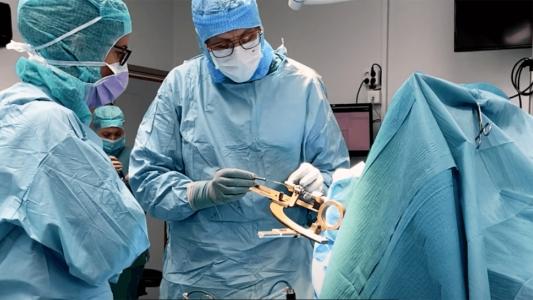One in three people with primary bone cancer will die within five years of diagnosis — but a new drug has the potential to help patients live longer without subjecting them to painful or unpleasant treatments.
The challenge: Cancer that starts in the bones is rare, with fewer than 4,000 new diagnoses every year in the US. However, 25% of those cases are people under the age of 20, and because bone cancer spreads rapidly, treatments are often drastic.
“Currently children have to undergo very toxic treatment, which has very unpleasant and sometimes life-long side effects, and sometimes life-changing amputation,” said co-author Alison Gartland from the University of Sheffield.
“It would be a much kinder treatment for children with bone cancer.”
Darrell Green
What’s new? Now, Garland and colleagues from the University of East Anglia (UEA) are developing a new bone cancer treatment that they hope will not only be more effective, but also more tolerable for patients.
For their latest study, the team used sequencing technology to analyze bone and tumor samples donated by 19 patients. This led to the discovery that a gene called RUNX2 is activated in bone cancer.
According to the researchers, the protein this gene expresses is not usually required by normal cells, but it does help bone cancer spread, so they developed a drug, called “CADD522,” that blocks its effect.
“We want to save lives and reduce the amount of disability caused by surgery.”
Darrell Green
In preclinical trials of mice implanted with human bone cancer, CADD522 increased metastasis-free survival rates by 50%. That means treated animals lived 50% longer than untreated animals before they had to be put down due to effects of their cancer spreading.
“The new drug that we have developed is effective in all of the main bone cancer subtypes and, so far, our experiments show that it is not toxic to the rest of the body,” lead researcher Darrell Green from the UEA told BBC News.
“This means that it would be a much kinder treatment for children with bone cancer, compared to the grueling chemotherapy and life-changing limb amputation that patients receive today,” he continued.
Looking ahead: The drug is now undergoing more testing so that the researchers will have the data needed to seek approval for a clinical trial.
Many treatments that work in mice don’t translate to people, but Green — who lost a childhood friend to bone cancer — is optimistic about this one.
“Ultimately, we want to save lives and reduce the amount of disability caused by surgery,” he said, “and now we have developed a new drug that potentially promises to do just that.”
We’d love to hear from you! If you have a comment about this article or if you have a tip for a future Freethink story, please email us at [email protected].






